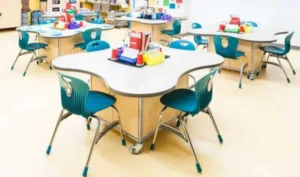The US ed-tech conference season kicks off with a strong event, the Future of Education Technology Conference (FETC 2018), held each year in Orlando, Florida. Now in its 37th year, this year’s visit led to some real surprises.

As soon as the exhibit hall opened, my pace quickened as I rushed in to see what exciting new educational technologies lay in store for us, especially in the VR arena. To my complete surprise, the very first virtual-reality stocked booth was…wait for it…a furniture supplier. At first, a timid ho-hum sounded off in my mind, but after a few seconds, my instincts beckoned me to stay a bit longer and ask a few probing questions. I’m glad I did.
The booth in question was sponsored by Interior Concepts, an innovative school furniture company, offering new categories of classroom furnishings, such as their motion collaboration tables. At first glance, a furniture company doesn’t seem all that sexy. All furniture really does, it seems, is provide the ‘platform’ on which your technology, and its youthful handlers, sit. There’s nothing much there, right? Wrong.
At educational conferences in 2018, the “learning spaces redesign” movement is big and getting bigger and display technologies have both central and ancillary roles in this reshaping. The 2017 Horizon report warns that “active learning spaces have the characteristics of being mobile, flexible, varied, and connected — [while valuing] tables, stations, and hubs over rigid structures.” The movement itself signals a major shift in schools that cannot be ignored: transforming the classroom from being teacher-centered to learner-centered. At the heart of this movement resides this question: “How do we make learning spaces that more effectively contribute to learning?” And, clearly, as the physical classroom evolves, so display and projection technologies must adapt.
Returning to my thoughts about the Interior Concepts booth, the most startling realization was that there was no furniture physically displayed in this very small, downsized booth. They did, however, have VR tours of their classroom installations available to passersby. A customer could view an Interior Concepts classroom from any angle; get on their knees and check underneath the furniture; or even walk around inside the virtual classroom, stocked with new furniture. Interesting.
I began to think of the headaches of displaying technology furniture at most conferences: formidable shipping and set up costs; outrageous floor space requirements and associated costs; and extremely low readouts on the “sexy technology booth” meter, which causes most educators to just pass on by. Of course, that was all gone. Just two sales associates, a display table for sales literature, signage and their VR goggles remained. That’s all there was. The cost reduction, hassle lessening, and customer appeal advantages were apparent. Here’s how they explained the thinking behind their. Completely virtual customer experience in the exhibit hall:
As I continued my line of questioning for the Interior Concepts staff about the creative use of virtual-reality in the display booth, I asked them about other apparent advantages of employing the virtual reality meme. Apparently, they’ve discovered another benefit of leveraging virtual reality in their sales efforts: persuasion. It provided a perfect example, at the school or district level, of the value of virtual-reality to persuade often fickle educational customers:
I have to confess that this is the first time I have seen virtual reality substitute for physical display, in entirety, as opposed to serving as an enhancement, at an educational conference. It worked. I’d certainly like to see more of it. I bet I will.– Len Scrogan

